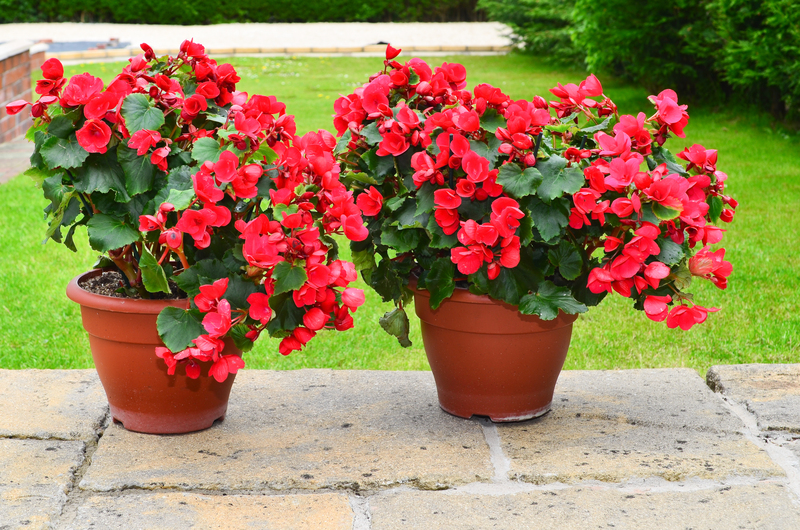The secrets to successful container gardening
Posted on 02/09/2025
The Secrets to Successful Container Gardening
Container gardening is a delightful and increasingly popular way to bring nature into your home or workspace, to maximize limited outdoor areas, or to simply enjoy the therapeutic act of growing beautiful flowers, tasty vegetables, or lush foliage wherever you choose. But what does it take to create a lush, healthy, and thriving potted landscape? Unveil the secrets to successful container gardening with our comprehensive guide, packed with tips, expert know-how, and actionable advice for beginners and seasoned gardeners alike.
Why Choose Container Gardening?
There are many compelling reasons why container gardening is embraced by so many people worldwide. Among them:
- Flexibility: Move your containers to optimize sunlight, fill empty spots, or redecorate easily.
- Accessibility: Gardening off the ground reduces bending or kneeling, making it suitable for all ages.
- Versatility: Perfect for balconies, patios, rooftops, small yards, and even indoors.
- Control: You have better command over soil quality, watering, and pest management.
With the right knowledge and approach, you can turn any space into a vibrant oasis. Let's explore the key principles for a successful container garden.

Choosing the Right Containers
The foundation of any container gardening project is, of course, the container itself. Consider these essential factors:
Material Matters
Containers come in a variety of materials--including clay, ceramic, plastic, metal, and wood. Each has its benefits and drawbacks:
- Terracotta/Clay: These are porous and stylish, allowing air to reach roots but can dry out quickly.
- Plastic: Lightweight and retains moisture longer, making it ideal for busy gardeners.
- Wood: Natural appearance and good insulation but may rot over time without proper treatment.
- Metal: Modern look, but may heat up quickly in the sun and overheat roots.
- Ceramic/Glazed: Retains water well and looks decorative, but can be heavy and expensive.
Pick containers that suit your aesthetics and meet your plants' water and root needs.
Size and Drainage
The size of your container is crucial. Here's why:
- Root Space: Larger containers provide more room for root development, yielding healthier plants.
- Water Retention: Bigger volumes of soil hold moisture longer, reducing watering frequency.
- Stability: Heavier containers are less likely to tip over in strong winds or from top-heavy plants.
- Drainage: Always ensure containers have adequate drainage holes.
Drainage is non-negotiable: Without it, water accumulates, leading to root rot and plant failure. If your pot doesn't have holes, add some.
Selecting the Best Potting Mix
Unlike traditional garden soil, a dedicated container gardening soil mix is specifically designed for the unique conditions of a pot.
Build the Perfect Blend
A high-quality potting mix should be:
- Lightweight and fluffy to prevent soil compaction and promote root growth.
- Well-draining yet able to retain enough moisture.
- Nutrient-rich to support healthy plants.
- Free from pests, pathogens, and weed seeds.
Most commercial mixes contain peat moss, coconut coir, vermiculite, and perlite. For organic gardening, look for certified organic mixes. You can enhance commercial blends with slow-release fertilizers or compost for extra nutrition.
Choosing the Best Plants for Container Gardening
Some plants are naturally more suited to container life than others. Here are a few golden rules:
Read the Plant Tags
- Light requirement: Does your plant prefer sun, shade, or something between?
- Mature size: Avoid overcrowding by matching the plant's mature size to the container's volume.
- Water needs: Group plants with similar water needs together for easier maintenance.
Compact varieties, dwarf species, and those labeled 'ideal for containers' are excellent bets.
Mixing and Matching: The Thriller, Filler, Spiller Principle
Landscape designers often suggest this trio for balanced, harmonious combinations:
- Thriller: Eye-catching centerpiece plant (e.g., ornamental grass, tall flower, or bold foliage).
- Filler: Mounding, spreading plants that fill out the arrangement (e.g., marigolds, petunias, coleus).
- Spiller: Cascading plants that drape over the edge (e.g., ivy, vinca, sweet potato vine).
Combine different colors, textures, and heights for dynamic visual appeal and flourishing container plantings.
Watering Secrets for Lush Container Gardens
Watering is arguably the most critical--yet frequently misunderstood--aspect of successful container gardening.
Check Moisture Regularly
- Stick your finger 1-2 inches into the soil to test moisture before watering.
- Containers typically dry out faster than garden beds, especially outdoors or during hot weather.
- Self-watering pots and drip irrigation systems can help automate and simplify irrigation.
How Much and When?
- Morning watering is best to reduce evaporation and allow leaves to dry before nightfall, minimizing disease risk.
- Always water deeply--until you see water draining from the bottom to ensure entire root zones are hydrated.
- Less frequent, deep watering beats daily shallow sprinkling for root health.
Fertilizing for Maximum Growth
Potted plants rely on you for nutrition. The limited volume of soil in a container means nutrients are quickly depleted.
Choose the Right Fertilizer
- Slow-release fertilizers are incorporated into the soil mix and provide a steady supply over weeks or months.
- Liquid fertilizers can be added to your watering routine for quick absorption, ideal for fast-growing annuals or vegetables.
- Organic options like fish emulsion, seaweed extract, or compost tea boost microbial activity and improve resilience.
Always follow the recommended dosage, as over-fertilizing can harm plant roots. "Feed little, feed often" is the golden rule for healthy container gardens.
Sunlight: Optimizing Exposure for Healthy Growth
Sunlight is the lifeblood of your container garden. Different plant species require different levels of sun.
How to Position Your Pots
- Full Sun: 6-8 hours of direct sunlight daily (e.g., most vegetables and flowering annuals).
- Partial Sun: 3-6 hours, ideally in the morning or late afternoon.
- Shade: Less than 3 hours of direct sunlight (ferns, impatiens, and other shade-lovers).
*Use a sun calculator app or observe your space during the day to see how sunlight moves and place your pots accordingly. Remember--containers are portable! Shift them as needed to get the ideal light conditions.
Pest and Disease Management in Container Gardens
While containers offer some natural protection, pests and diseases can still strike, endangering your container plants.
Prevent Problems Before They Begin
- Use sterile potting mix to minimize soil-borne pathogens.
- Clean containers before replanting each season.
- Inspect plants before purchasing and introducing to your home or garden.
Early detection and intervention are vital--check your plants often for spots, holes, pest droppings, or signs of distress.
The Best Natural Solutions
- Hand-pick pests when possible.
- Encourage beneficial insects like ladybugs and lacewings.
- Spray with insecticidal soap or a homemade garlic and chili spray for soft-bodied pests.
- Remove infected foliage promptly to prevent the spread of disease.
- Maintain good airflow by not overcrowding containers--healthy containers mean fewer diseases.
Seasonal Secrets: All-Year Container Gardening
One of the greatest joys of container gardening is being able to adapt your display year-round--regardless of climate.
Spring and Summer
- Opt for bold, colorful annuals and edibles (tomatoes, peppers, basil, marigolds).
- Water and fertilize often as plants are actively growing.
- Use mulch to conserve moisture and reduce weeds.
Autumn
- Switch to cold-hardy choices like kale, pansies, ornamental cabbage, and mums.
- Add decorative gourds and pumpkins for seasonal flair.
- Reduce watering as growth slows.
Winter
- In cold regions, use frost-tolerant plants like evergreen shrubs or switch to indoor containers.
- Wrap pots with burlap, bubble wrap, or insulating materials to protect roots from freeze-thaw cycles.
- Water sparingly--plants need less as they go dormant.
Creative Ideas for Stunning Container Gardens
Let your imagination shine! Here are some innovative ways to personalize your container gardening experience:
- Themed Containers: Try a culinary herb garden, a night-scented flower pot, or a butterfly-attracting arrangement.
- Upcycled pots: Use vintage teapots, baskets, old boots, or crates lined with landscape fabric for rustic charm.
- Vertical gardening: Wall-mounted pockets and stacked planters save space and make striking living art.
- Mix perennials, annuals, and bulbs for all-season interest.
Remember: There are no hard-and-fast rules. If you love it and your plants are happy, you've mastered the art of container garden design!

Common Mistakes to Avoid in Container Gardening
- Using garden soil instead of quality potting mix--garden soil compacts and drains poorly in containers.
- Overcrowding plants--leaves little room for growth and increases disease risk.
- Neglecting drainage--always ensure excess water can escape.
- Watering inconsistently--drought and soaking cycles stress plants.
- Choosing the wrong plant for your light conditions--read those plant labels!
- Forgetting to feed--container plants need more regular fertilizer than in-ground gardens.
Conclusion: Unlock the Secrets of Container Gardening Success
Container gardening is a truly rewarding way to cultivate beauty, flavor, and tranquility in any environment--no matter how humble or grand your space may be. By learning these key secrets--selecting the right pots, soil, and plants; providing proper water, nutrients, and sunlight; managing pests; and adapting to the seasons--you can enjoy vibrant, healthy containers all year round. Don't be afraid to experiment, try new things, and let your creativity flow.
Ready to dig in? Start today and discover the endless possibilities of your very own container garden paradise!
Frequently Asked Questions about Container Gardening
-
Q: Can I grow vegetables in containers?
A: Absolutely! Many vegetables--tomatoes, peppers, lettuce, and herbs--thrive in containers with the right care. -
Q: How often should I water my container plants?
A: Water needs vary, but most containers require more frequent watering than garden beds, especially in summer. Check soil moisture daily. -
Q: What's the best pot size for beginners?
A: Start with pots at least 12 inches in diameter--they're easier to manage, stay moist longer, and offer ample room for growth.
Now that you know the secrets to successful container gardening, the only limit is your imagination and enthusiasm!



